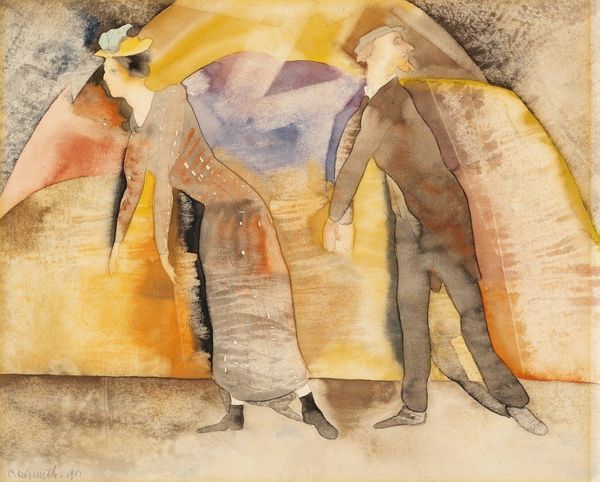
Copyright: Public domain
Editor: Here we have Dorrit Black’s watercolor painting, “On the Rocks, England,” created in 1935. I'm struck by how the artist uses a somewhat abstract approach to capture a seemingly casual beach scene. What’s your interpretation of the way Black has rendered this English landscape? Curator: It’s fascinating to consider how Black, an Australian artist, visualizes England through the lens of modernism in the 1930s. The interwar period saw increased interest in leisure and the outdoors, and paintings like this participated in shaping and reflecting those evolving cultural values. Notice how she simplifies the figures and the landscape, flattening the pictorial space. It departs from traditional landscape painting to suggest a kind of social realism reflecting the increasing democratization of leisure, don't you think? Editor: Yes, the flattening almost makes the scene feel staged, which gives it a sense of universality beyond just a simple depiction of a beach in England. Curator: Exactly! And consider her use of watercolor, typically associated with more delicate, ‘feminine’ subjects. Here, Black uses it to create a rather robust, almost architectural, structure of forms. What do you think that juxtaposition might be suggesting about her role as a female artist pushing boundaries within established artistic traditions? Editor: That’s a great point! It really does challenge those gendered assumptions, using what was considered a ‘feminine’ medium in a powerfully unconventional way. Curator: It's an artwork that offers us insight into both artistic innovation and societal shifts of the time. By exploring how artists use stylistic elements, we can unpack not just visual pleasure, but cultural statements and societal influences, can’t we? Editor: Definitely. I’m seeing the painting now in an entirely different context! Thank you.
Comments
No comments
Be the first to comment and join the conversation on the ultimate creative platform.













